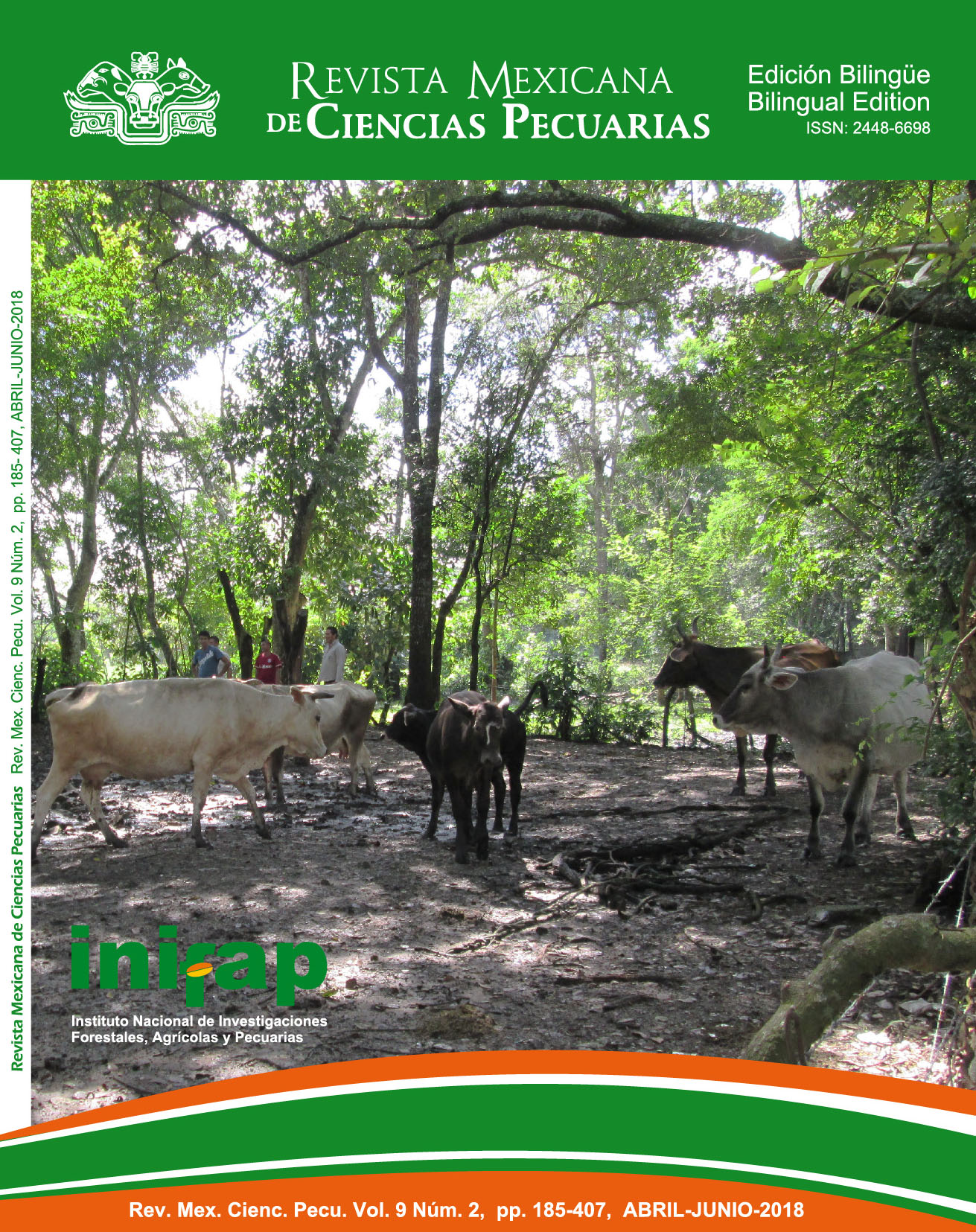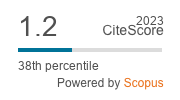Productividad, características fisicoquímicas y digestibilidad in vitro de leguminosas forrajeras en trópico seco de México
DOI:
https://doi.org/10.22319/rmcp.v9i2.4361Palabras clave:
Macroptilium atropurpureum, Macroptilium lathyroides, Phaseolus acutifolius, Materia seca, Calidad nutritiva.Resumen
Tres leguminosas herbáceas: Macroptilium lathyroides, Macroptilium atropurpureum y Phaseolus acutifolius se sembraron en 12 unidades experimentales de 28 m2 cada una, bajo un diseño de bloques completos al azar y cuatro repeticiones por especie. El objetivo fue evaluar las características de producción de materia seca (MS), relación hoja-tallo y cobertura, así como la concentración de proteína cruda (PC), fibra detergente neutro (FDN), fibra detergente ácido (FDA), lignina (LDA), taninos, fenoles y digestibilidad in vitro de la MS (DIVMS) en todo el ciclo biológico de las especies. La producción promedio de MS (kg ha-1) difirió (P<0.05) entre especies, resultando mayor para M. lathyroides (4,655), intermedia para M. atropurpureum (3,920) y menor (2,170) para P. acutifolius. La diferencia en producción de MS entre M. lathyroides y M. atropurpureum fue un reflejo principalmente de diferencias en la altura de la planta, más que a diferencias en la relación hoja-tallo o cobertura. M. lathyroides y M. atropurpureum no fueron diferentes (P>0.05) en concentración de PC, FDN, FDA y DIVMS. La especie P. acutifolius mostró una menor concentración de todas las fracciones y una menor DIVMS. La concentración de taninos (g kg-1 MS) fue mayor (P<0.05) para M. lathyroides (3.93), intermedia para M. atropurpureum (3.14) y menor (1.82) para P. acutifolius. En fenoles, las especies no fueron diferentes, obteniendo un promedio de 20.3 g kg-1 MS. Se concluye que M. lathyroides y M. atropurpureum fueron las especies con mejor comportamiento productivo y calidad nutritiva en toda la fase experimental.
Descargas
Citas
Solanki GS. Feeding habits and grazing behavior of goats in a semi-arid region of India. Small Ruminant Res 1994;14(1):39-43.
Lebopa CK, Boomker EA, Chimonyo M, Mulugeta SD. Factors affecting the feeding behavior of tree ranging Tswana and Boer goats in the false Thornveld of the Eastern Cape, South Africa. Life Sci J 2011;8:70-80.
Njarui DMG, Wandera FP. Effect of cutting frequency on productivity of five selected herbaceous legumes and five grasses in semi-arid tropical Kenya. Trop Grassl 2004;38(3):158-166.
Njoka-Njiru EN, Njarui MG, Abdulrazak SA, Mureithi JG. Effect of intercropping herbaceous legumes with Napier grass on dry matter yield and nutritive value of the feedstuffs in semi-arid region of eastern Kenya. Agric Trop Subtrop 2006;39(4):255-267.
Njarui DMG, Njoka EN, Abdulrazak SA, Mureithi JG. Effect of planting patterns of two herbaceous forage legumes in fodder grasses on productivity of grass/legume mixture in semi-arid tropical Kenya. Trop Subtrop Agroecosyst 2007;7(2):73-85.
Macharia PN, Kinyamario JI, Ekaya WN, Gachene CKK. Enhancement of grassland production through integration of forage legumes in semi-arid rangelands of Kenya. Trop Grassl 2005;39:234.
Mero RN, Udén P. Promising tropical grasses and legumes as feed resources in central Tanzania IV. Effect of feeding level on digestibility and voluntary intake of four herbaceous legumes by sheep. Anim Feed Sci Technol 1998;70(1):97-110.
Mupangwa JF, Ngongoni NT, Toops JH, Ndlovu P. Chemical composition and dry matter degradability profiles of forage legumes Cassia rotundifolia cv. Wynn, Lablab purpureus cv. Highworth and Macroptilium atropurpureum cv. Siratro at 8 weeks of growth (pre-anthesis). Anim Feed Sci Technol 1997;69(1):167-178.
Matizha W, Ngongoni NT, Toops JH. Effect of supplementing veld hay with tropical legumes Desmodium uncinatum, Stylosanthes guianensis and Macroptilium atropurpureum on intake, digestibility, outflow rates, nitrogen retention and live weight gain in lambs. Anim feed Sci Technol 1997;69(1):187-193.
Mupangwa JF, Ngongoni NT, Topps JH, Acamovic T, Hamudikuwanda H, Ndlovu LR. Dry matter intake, apparent digestibility and excretion of purine derivatives in sheep fed tropical legume hay. Small Ruminant Res 2000;36(3):261-268.
Undi M, Kawonga KC, Musendo RM. Nutritive value of maize stover/pasture legume mixtures as dry season supplementation for sheep. Small Ruminant Res 2001;40(3):261-267.
Mureithi JG, Gachene CKK, Ojiem J. The role of green manure legumes in smallholder farming systems in Kenya: The Legume Research Network Project. Trop Subtrop Agroecosyst 2003;1(2-3):57-70.
Ankom T. Operator's manual. Ankom Technology, Macedon, New York 2006.
AOAC. The Official Methods of Analysis of AOAC International. Association of Official Analytical Chemist. 17th ed. Washington, USA. 2000.
García DE, Ojeda F. Evaluación de los principales factores que influyen en la composición fitoquímica de Morus alba (L.). II Polifenoles totales. Pastos y Forrajes 2004;27(1):59-64.
Norma Mexicana; NMX-Y-326-SCFI-2004. Alimentos para animales-determinación de taninos en sorgo-método de prueba. Disponible en: http://www.dof.gob.mx/nota_ detalle.php?codigo=672457&fecha=22/04/2004. Consultado 25 Nov, 2015.
Jones DIH, Hayward MV. The effect of pepsin pretreatment of herbage on the prediction of dry matter digestibility from solubility in fungal cellulase solutions. J Sci Food Agric 1975;26:711-718.
Clarke T, Flinn PC, Mcgowan AA. Low-cost pepsin-cellulase assays for prediction of digestibility of herbage. Grass Forage Sci 1982;37:147-150.
SAS (Statistical Analysis System). User's Guide: Statistics, version 9.0. SAS Institute Inc., Cary, North Caroline, USA; 2002.
Steel RGD, Torrie JH. Principios y procedimientos de estadística. Segunda ed. México: McGraw-Hill Book Co; 1981.
Nakanishi Y, Tsuru K, Bungo T, Shimojo M, Masuda Y, Goto I. Effects of growth stage and sward structure of Macroptilium lathyroides and M. atropurpureum on selective grazing and bite size in goats. Trop Grassl 1993;27:108-113.
Shaw NH, Whiteman PC. A success story in breeding a tropical pasture legume. Trop Grassl 1977;11(1):7-14.
Mbuthia EW, Gachuiri CK. Effect of inclusion of Mucuna pruriens and Dolichos lablab forage in Napier grass silage on silage quality and on voluntary intake and digestibility in sheep. Trop Subtrop Agroecosyst 2003;1(2-3):123-128.
Adjolohoun S, Buldgen A, Adandedjan C, Decruyenaere V, Dardenne P. Yield and nutritive value of herbaceous and browse forage legumes in the Borgou region of Benin. Trop Grassl 2008;42(2):104-111.
Evitayani LW, Fariani A, Ichinohe T, Fujihara T. Study on nutritive value of tropical forages in north Sumatra, Indonesia. Asian-Aust J Anim Sci 2004;17(11):1518-1523.
Njarui DMG, Mureithi JG, Wandera FP, Muinga RW. Evaluation of four forage legumes as supplementary feed for Kenya dual-purpose goat in the semi-arid region of eastern Kenya. Trop Subtrop Agroecosyst 2003;3(2):65-71.
Mupangwa JF, Ngongoni NT, Hamudikuwanda H. The effect of stage of growth and method of drying fresh herbage on chemical composition of three tropical herbaceous forage legumes. Trop Subtrop Agroecosyst 2006;6:23-30.
Matizha W, Ngongoni NT, Toops JH, Sibanda, S. Chemical composition of three herbaceous tropical forage legumes grown successfully in Zimbabwe. JASSA 2001;7(2):73-82.
Mero RN, Udén P. Promising tropical grasses and legumes as feed resources in central Tanzania V. Effect of supplementing Cenchrus ciliaris hay with leaves from four legumes on intake and digestibility by growing Mpwapwa bulls. Anim Feed Sci Technol 1998;70(1):111-122.
López HMA, Rivera LJA, Ortega RL, Escobedo MJG, Magaña MMA, Sanginés GJR, Sierra VAC. Nutritional composition and antinutritional factor content of twelve native forage species from northern Quintana Roo, Mexico. Téc Pecu Méx 2008;46(2):205-215.
García DE, Medina MG, Domínguez C, Baldizán A, Humbría J, Cova L. Evaluación química de especies no leguminosas con potencial forrajero en el estado Trujillo, Venezuela. Zootec Trop 2006;24(4):401-415.
Mupangwa JF, Acamovic T, Topps JH, Ngongoni NT, Hamudikuwanda H. Content of soluble and bound condensed tannins of three tropical herbaceous forage legumes. Anim Feed Sci Technol 2000;83(2):139-144.
Waghorn GC, Ulyatt MJ, John A, Fisher MT. The effect of condensed tannins on the site of digestion of amino acids and other nutrients in sheep fed on Lotus corniculatus L. Brit J Nutr 1987;57(01):115-126.
Dewhurst RJ, Delaby RJ, Moloney A, Boland T, Lewis E. Nutritive value of forage legumes used for grazing and silage. Irish J Agric Food Res 2009;48:167-187.
Alonso-Díaz MA, Torres-Acosta JFJ, Sandoval-Castro CA, Hoste H. Tannins in tropical tree fodders fed to small ruminants: A friendly foe? Small Ruminant Res 2010;89(2):164-173.
Enríquez QJF, Meléndez NF, Bolaños AED, Esqueda EVA. Producción y manejo de forrajes tropicales. Primera ed. Instituto Nacional de Investigaciones Forestales, Agrícolas y Pecuarias (INIFAP). Centro de Investigación Regional Golfo Centro, Campo Experimental La Posta, Medellín de Bravo Veracruz, México 2011.
Barahona R, Lascano CE, Cochran R, Morrill J, Titgemeyer EC. Intake, digestion, and nitrogen utilization by sheep fed tropical legumes with contrasting tannin concentration and astringency. J Anim Sci 1997;75(6):1633-1640.
Publicado
Cómo citar
-
Resumen1301
-
PDF959
-
XML471
Número
Sección
Licencia
Los autores/as que publiquen en la Revista Mexicana de Ciencias Pecuarias aceptan las siguientes condiciones:
De acuerdo con la legislación de derechos de autor, la Revista Mexicana de Ciencias Pecuarias reconoce y respeta el derecho moral de los autores/as, así como la titularidad del derecho patrimonial, el cual será cedido a la revista para su difusión en acceso abierto.

Esta obra está bajo una Licencia Creative Commons Atribución-NoComercial-CompartirIgual 4.0 Internacional.





